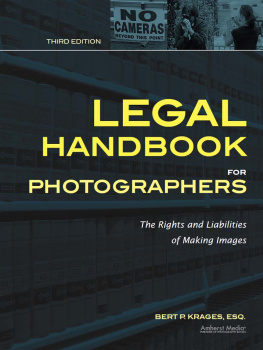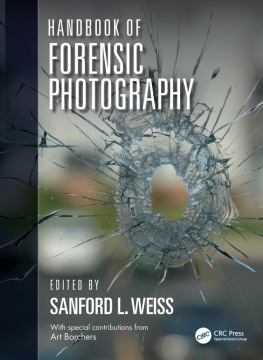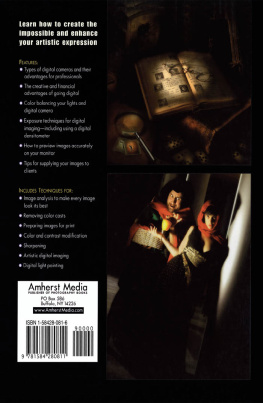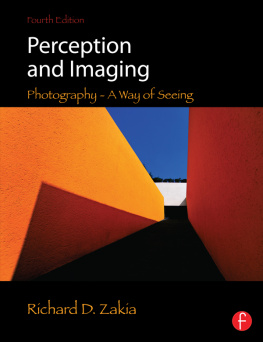For
MEREDITH
ABOUT THE AUTHOR
Bert P. Krages, Esq. is an attorney who specializes in intellectual property matters. He is nationally recognized as a public advocate for the rights of photographers to document what they see in public places.
Copyright 2012 by Bert P. Krages, Esq.
All rights reserved.
All photographs by the author unless otherwise noted.
Published by:
Amherst Media, Inc.
P.O. Box 586
Buffalo, N.Y. 14226
Fax: 716-874-4508
www.AmherstMedia.com
Publisher: Craig Alesse
Senior Editor/Production Manager: Michelle Perkins
Assistant Editor: Barbara A. Lynch-Johnt
Editorial Assistance from: Sally Jarzab, John S. Loder
Business Manager: Adam Richards
Marketing, Sales, and Promotion Manager: Kate Neaverth
Warehouse and Fulfillment Manager: Roger Singo
ISBN-13: 978-1-60895-475-9
Library of Congress Control Number: 2011942805
Printed in The United States of America.
10 9 8 7 6 5 4 3 2 1
No part of this publication may be reproduced, stored, or transmitted in any form or by any means, electronic, mechanical, photocopied, recorded or otherwise, without prior written consent from the publisher.
Notice of Disclaimer: The information contained in this book is based on the authors experience and opinions. The author and publisher will not be held liable for the use or misuse of the information in this book.
Check out Amherst Medias blogs at: http://portrait-photographer.blogspot.com/
http://weddingphotographer-amherstmedia.blogspot.com/
T ABLE OF C ONTENTS
4. R ESTRICTIONS ON S UBJECT M ATTER
P REFACE TO THE T HIRD E DITON
T he first edition of this book was released on September 1, 2001. A few days later, terrorist attacks in New York, Washington, D.C., and Pennsylvania created an environment in which many photographers faced suspicion, and even confrontation, as they went about their normal activities. Fortunately, the laws affecting photography did not change in response to the attacks. Nonetheless, there was a genuine need that photographers come to better understand the legal aspects of taking images and to stand up for their rights. I take some pride in the fact that the Legal Handbook and the Photographers Right document (available for download at www.krages.com) played a role in educating photographers on how to cope with the sometimes paranoid post-September 11 environment.
The first edition of Legal Handbook for Photographers emphasized the rights regarding the taking of photographs and provided guidance on to how to handle confrontations. The second edition, in light of the burgeoning practice of photographers of all ilk publishing their images, provided more information about protecting copyrights and the legal aspects of publishing images. The third edition reflects some of the changes in the law as they affect photography and adds material to cover developing areas that affect photographers. For example, digital imaging and the widespread adoption of video and audio capabilities in lower-end cameras has resulted in another area of the law becoming increasingly important to photographers: the recording of conversations. The third edition thus provides material on such issues.
The material in this book is intended to inform readers about the general legal principles that apply to taking and publishing photographs within the United States. It cannot substitute for legal advice and readers should seek counsel from a competent attorney when they need such advice. Readers should be aware that laws change and some of the material in this book may (and will) become outdated over time. Because it is impossible to describe every applicable law in a book of this nature, it should not be used a comprehensive guide to the laws as they apply in individual states.
1. T HE I MPORTANCE OF K NOWING Y OUR R IGHTS
T he purpose of this book is to introduce photographers to the basic legal principles that govern the making and publishing of photographs, as well as some of the practical aspects of dealing with the issues raised by such laws. It should be emphasized at the beginning that, for the most part, society favors the benefits that photography offers and this is reflected in legal principles that are mostly permissive towards taking photographs and publishing them in print and on the Internet. This does not mean that there are no restrictions. In cases where photography can infringe on important societal interests, such as national security or protecting children from sexual exploitation, it may be strictly controlled. Likewise, property owners are generally free to limit activities that take place on their property. This means that if a bank manager does not want you to take photographs while you are in the bank, then he is legally entitled to prohibit you from taking photographs. However, he would not be entitled to prohibit you from photographing the exterior of a bank while standing across street nor could he prohibit you from posting the images on your website.
WHY YOU SHOULD KNOW ABOUT THE LAW
Although we live in a society with a seemingly insatiable appetite for images, it cannot be denied that concerns about security and privacy have increased the level of anxiety that some people have regarding photography. Photographers have been challenged for photographing the most mundane subject matter, often for the most illogical reasons. Many of the people initiating confrontations have either a gross misunderstanding of the law as it affects photography or act out of a self-centered sense of indignation. Photographers who do not understand the basic rights about what, where, and when they can photograph tend to approach legal issues with blissful ignorance, excessive caution, or reckless abandon. A mother who photographs her two-year-old son playing naked by a lawn sprinkler may assume the innocuous nature of the images will keep her out of trouble. A street photographer may forgo documenting the history of a community because some uninformed persons tells him that anti-terrorism laws prohibit taking photographs of city buses (they do not). More brazen photographers may cross the lines of propriety by trespassing in order to obtain provocative images of matters such as a celebritys private activities (attorneys occasionally refer to these kind of photographers as defendants). Each of these photographers may suffer as a result of their approach to the legal issues associated with photography.
Insight into the law can make you a more effective photographer, because it enables you to exercise judgment in a way that allows you to achieve your objectiveseven in difficult situations. For example, would you know your rights if a police officer asked you to hand over your memory card after photographing a violent arrest? Likewise, how would you respond if a local Little League coach told you that you could not photograph a game being played in a city-owned park because of laws against child molestation? And what are your remedies if your rights to take photographs are violated? Photographers can better handle confrontations when they feel secure about their rights and know about their potential remedies should those rights be violated.
Photographers who know the law are better able to find options that minimize their legal risks. Sometimes the solution is obvious, such as composing shots to exclude an incidental but legally problematic subject. Other times, understanding the practical aspects of the legal system can help solve difficult or awkward situations. For example, many people assume that lawsuits are always about recovering money and are unaware that emotional issues are the root of many kinds of litigation. Interpersonal skills and simple courtesy are not only effective when it comes to avoiding confrontations and lawsuits, they can be skillfully used to produce opportunities that are denied to the less knowledgeable.
Next page








